|
|
"He who
wonders discovers that this in itself is wonderful"
- M. C.
Escher |
Contents
Pyramids, Platforms, Dolmens and Mounds
As is well known there are literally
hundreds of pyramids of various
styles scattered over the Earth, in Europe, Africa, the Middle East
and Far East, Southeast Asia and South Pacific, and in North and
South America.
A few of these sites demonstrating the different
styles are:
-
Iraq: The reconstructed
ziggurat-pyramid at Ur, in ancient Sumer.
-
Egypt: The step pyramid at Saqqara.
-
Egypt: The smooth-walled
pyramids at Giza. Hancock
and Bauval (1996) suggest that the ‘ground plan’
of the three great pyramids was physically established in 10,500
bc, but that the pyramids were built around 2,500 bc. This
supports the notion that the pyramid base rock with its
underground chamber was an early AA terminal, and the Sphinx was
the associated landmark easily identified from space.
-
Mexico: The highly decorated step
pyramids at Chichen-Itza, Monte Alban, and elsewhere. In the
Temple of Inscriptions at Palenque, a shaft runs from the tomb
up to the temple floor, similar to some of the Egyptian
pyramids. There was initially a 40 ft "comb" on the top. Was
this an additional identifying marker?
-
Mexico: The unusual elliptical
pyramid at Uxmal.
-
Mexico: The huge, unexcavated
pyramid at Cholula (Fig 4-1), in the shadow of the volcano,
Popocatepetl ("El Popo"). Its ancient name, Tlachihualtepetl,
means "man-made mountain". On Quetzalcoatl’s pilgrimage his
first stop was Cholula, which means ‘the place of flight’ in Nahuatl. The huge "Piramide Tepanapa", 200 ft high and 1300 ft
on a side, is the largest ancient pyramid in the Americas, and
possibly the largest in the world. The earliest construction has
been traced to 200 bc. It was covered with dirt to hide it from
the invading Spaniards and a small shrine was placed at the top,
which the Spanish replaced with a church (Fig 4-1). The small
portion which has been excavated reveals remarkable masonry (Fig
4-2).
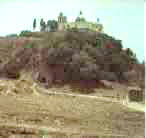
Fig 4-1
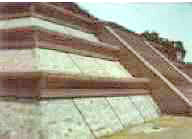
Fig 4-2
-
Mexico: Tres Zapotes, an Olmec site
(1300 – 400 bc), was the first adobe-brick pyramid site in
Mesoamerica. (Mystery buffs please note: Before the arrival of
Cortez ALL of the Olmec sites were destroyed, except El Tijin,
which had been abandoned!)
-
Mexico: The truncated cone pyramid
of Cuicuilco. In 1917 Manuel Gamio, excavating off the road from
Mexico City to Cuernavaca, found an overgrown hill called
‘Cuicuilco’ enveloped by pre-historic lava streams. It turned
out to be an enormous ancient pyramid or truncated cone with
four galleries and central staircase. It is one of the few
remaining round stepped pyramids. The base is 370 ft and it is
about 60 ft high now, although it was originally much higher.
Archeologist Paul Heinrich reports the age to be 800 to 600 bc,
not 6000 bc as reported by others. (Miller, 2000)
-
Mexico: The beautiful miniature
pyramid at Cecilia, D.F.
-
Mexico: The platform-pyramids at Teotenango, Tenayaca, and Tula.
-
Mexico: The multi-platform style of
the Pyramid of the Sun,
Teotihuacan. In his discussion of
Teotihuacan, John Michel (1995) quotes another researcher:
"During the 1970s Hugh Harleston, Jr …established that ‘the
basic unit of measurement at Teotihuacan was 1.0594 meters, the
same unit which represents the ‘Jewish rod’ of 3.4757 ft., the
same unit which represents the width of the Stonehenge lintels,
a six-millionth part of the earth’s polar radius…’"
-
Guatemala: The huge pre-classic (150
bc-150 ad) Mayan site of El Mirador with its dozens of pyramids,
including the Tigre Pyramid rising 18 stories high, probably the
largest pyramid ever built by the Maya.
-
Peru: Moche Temple of the Sun. The
earlier Moche built this temple-pyramid style pyramid from 140
million adobe bricks.
-
Peru: Sipan Pyramid. This Moche
pyramid-tomb near the town of Sipan proves that some of the
early SA pyramids were tombs, as in Egypt and Mesoamerica.
-
Peru: Pyramids of Cahuachi. A
ceremonial site comprised of six pyramids, the highest being
about 70 ft, overlooking a walled court of 4050 sq yards.
(Morrison, 1988). Hadingham (1987) mentions that the "great
temple" was a stepped pyramid. He quotes Helaine Silverman’s
estimate that the period of most activity at Cahuachi was short
lived, about 200 years, and the site was mysteriously abandoned
around 200 ad, along with other several other important sites.
-
Peru: The pyramids of Tucume.
"Covering over 540 acres and including 26 major pyramids as well
as myriad smaller structures…first built around 1100 ad by
people of the Lambayeque culture…" The largest of the adobe
brick pyramids, Huaca Larga, is 2300 ft long, 910 ft wide and 65
ft high. (Heyerdahl, 1995). Robert Schoch (1999) writes, "The
largest of the pyramids, called Tucume…was only a little over
200 feet high, but it contained one-third more volume that the
Pyramid of Khufu at Giza."
-
Peru: Huaca del Sol, Moche Valley.
This is a 120 ft high pyramid on the Peruvian north coast. The
1.5 million mud brick pyramid is the largest man-made mound in
SA. Facing Huaca del Sol across the main plaza was a smaller
mound, Huaca del Luna. The site lies at the foot of Cerro
Blanco, an obvious landmark from space for this
ceremonial/feeding center (Hadingham, 1987)
-
Bolivia: The Akapana platform-pyramid
at
Tiahuanaco. The Bolivian archaeologists date the site to 1580
bc. The Akapana measures 688 ft on a side and is 49 ft high.
"The earthen interior was shaped like a stepped pyramid and
faced with fitted stones." (Demetrio, 1983)
-
Java: Cani Sukuh pyramid, resembling
the Mexico pyramid style (Childress, 1996). Who carried this
style across the Pacific?
-
Ryukyu Islands: The
Yonaguni
underwater pyramid. This unique step-pyramid-platform, 240 ft
long and 90 ft high, resting 75 ft underwater, has been dated to
8000 bc! (Dopatka, 2000)
-
China: The
White Pyramid, near Xi’an.
Hartwig Hausdorf (1998) says there are 90-100 pyramids in China,
near Xi’an, the tallest being about 200 ft. Xi’an incidentally
is the site of the amazing ‘Terracotta Army’ of Qin Shi Huang.
-
Polynesia: "modest pyramids" at Tongatabu; a temple-pyramid on Tahiti; the Langi stepped
pyramid-platform at Tauhala (a large stone, 24 x 7 ft and
weighing 30-40 tons, is in the wall).
Ancient pyramids are also found on Samoa and Java. (Childress,
1996)
-
Greece: Pyramid of Hellinikon, near
Argos. The author writes, "…built in the style reminiscent of
cyclopean walls…" Its base is 15 x 13 meters, and the tallest
wall still standing it only 14 ft. From the photos it probably
would have stood about 10 meters high when completed.
Thermoluminescent analysis of the pyramid in 1997 yielded a
construction date of 2720 bc, older than the archeologists state
for the Cheops pyramid! (Tsoukalow, 2000)
-
Canary Islands: The pyramids of Guimar. Thor Heyerdahl writes, "…They were painstakingly built
step-pyramids, constructed according to similar principles as
those of Mexico, Peru, and ancient Mesopotamia."
-
United States: Monk’s pyramid-mound
at Cahokia, Illinois, a mud brick platform-pyramid. A large
stone wall or room has recently been discovered inside the
mound, but has not been excavated as of Oct 2000.
-
Yonaguni: Situated between the East
China Sea and the Philippine Sea, about 300 miles from Okinawa,
is the island of Yonaguni-Jima.
Off it's coast is a huge
apparently manmade (god-made?) monument about 100 ft below the
surface. Its a platform pyramid 600 ft wide, 90 ft high
constructed of precisely hewn megalithic stones. The pyramid,
apparently a part of a ceremonial center, has been dated to 8000 bc, 5000 years before the oldest pyramid in Egypt!
The best clue we have that the gods
orchestrated the pyramid building is the tale of Gudea who built the
temple-ziggurat at Lagash (apparently the god Kothar-Hasis was the
only one authorized to design the temples.
He was likely the same
"Greek divine craftsman Hepahaestus" who built the temple-abode of
Zeus, and the Egyptian god Thoth).
For Ninurta’s temple at Lagash Gudea was given elaborate and continuous instructions by
the gods.
He built a seven-tier ziggurat, named Eninnu, referring to a
ingenious tablet which gave a plan view and 7 scales – one for each
tier (Zecharia Sitchin describes this story in detail in
his 1976
and 1993 books. See also figs 748, 749 of Pritchard, 1969).
Zecharia Sitchin makes an interesting connection with his statement
that the three great pyramids of Giza are at 52 degree, but the
later pyramids collapsed at this angle and were built at 43.5
degrees, and he maintains that the pyramids at
Teotihuacan are also
at 43.5 degrees.
Furthermore,
"although the 2nd pyramid at Giza is
shorter than the Great Pyramid, their peaks are at the same height
above sea level because the 2nd one is built on higher ground; the
same holds true at Teotihuacan where the smaller Pyramid of the Moon
is built on ground some thirty feet higher than the Sun Pyramid,
giving their peaks equal height above sea level."
We should note
here also that both the Great Pyramid at Giza and the Sun Pyramid at
Teotihuacan have a descending shaft burrowed into the bedrock on
which the pyramids were built.
One of the problems in choosing a landing site for a vertical-lift
aircraft is the dust and dirt generated by the exhaust. Before
pyramids were built this problem was apparently minimized by landing
on large rock outcrops.
The problem is better solved however by landing on step pyramids, or
step platforms, since the tiers at each level would effectively
deflect the exhaust (Fig 4-3).
|
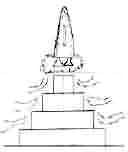
Fig 4-3
Deflection of rocket exhaust
by stepped pyramid design |
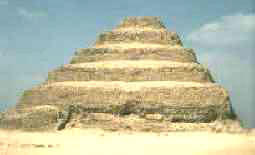
Fig 4-4
Zoser pyramid in Egypt |
The ziggurats at Urand Babylon, the
Zoser pyramid in Egypt (Fig 4-4), the Canary Island pyramids, and
most of the Mexican pyramids and South American pyramids, employed
this design.
Interestingly some of the Egyptian pyramids have multiple chambers
which seem to have been built over periods of time, e.g. Sneferu’s
pyramid has an underground chamber, a 2nd chamber near the surface,
and a 3rd chamber up in the pyramid, as if the site was in use
before, possibly long before, the pyramid was erected, probably as a
landing and feeding site.
The chambers of the Great Pyramid also
follow this pattern; the 1st one being deep underground, then the
2nd (‘Queens’) chamber built low in the center of the pyramid, and
the 3rd (‘Kings’) chamber higher up. This pattern suggests that one
goal was to provide continuous and increasing degrees of protection
from above.
The pyramids of Mycerinus, Unas, Teti and most others also had
underground chambers. In fact the pyramids of Mycerinus and some
others did not even have chambers in the pyramids themselves - all
chambers were underground! Obviously this design would make
excellent bomb shelters, and I suspect that the large pyramids, and
any hapless occupants, if they had been located at "ground zero" at
Hiroshima or Nagasaki, would have survived. The pyramidal shape
would have effectively deflected most of the blast wave and
fireball, and the neutron and gamma-ray pulses would have been
attenuated to negligible levels by the stone mass.
Zecharia Sitchin (1985) offers a rather fantastic function for
the
pyramids of Giza: that they were built by
the Nefilim, not by
mankind, as part of a guidance grid for "the Tilmun spaceport".
He
develops a theory that ties the pyramids and the "sacred cities"
into a guidance and communication grid for two approach corridors,
one west-to-east over Mesopotamia and one west-to-east over the
Sinai.
"Built by the gods (Anunnaki), they
were landmarks and beacons for the spaceport in Sinai, and
existed long before kingship began in Egypt.
"The great pyramid was "…the mountain by which Utu ascends…".
Regarding the Giza pyramids some
scholars argue that the stones were pulled up long ramps on sleds,
referencing the familiar painting from the tomb of Djehutihotepe of
204 workers moving his 60 ton statute on a sled (Fig 4-5).
But this
only proves that this statue was moved on a sled. I am not aware of
a single image or inscription which depict the methods used to
construct the great pyramids.
We simply do not know how it was done.
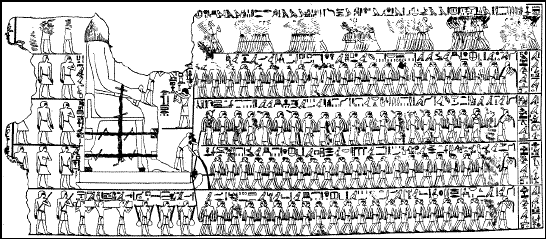
Fig 4-5
Incidentally
Mark and
Richard Wells
(2000) have discovered an amazing similarity in the alignment and
size of the three stars in Orion's belt and the alignment and size
of the major pyramids at Giza, Egypt; Xi'an, China;
Teotihuacan,
Mexico. Don't miss their essay.
So we have pyramids of heights ranging from 30 ft to over 400 ft,
lengths from 100 ft to 2300 ft; some with inner chambers and some
solid throughout; stepped and smooth walled; square, round and
elliptical bases; stone, mud and adobe brick construction; highly
decorated or plain; some topped with small buildings.
From these various styles, sizes, and composition I think we can
conclude that the pyramids had several functions: burial sites,
landmarks, landing sites, feeding stations, bomb shelters, and
ceremonial sites; and there is evidence that many of them served
several functions simultaneously.
But one thing seems certain – the
pyramids, platforms and mounds around the world were places where
the gods and mankind came together.
Back to Contents
The Megalith
Builders
Yahweh questions Job:
“Let me ask thee, and answer thou me: Where wast thou, when the
Earth’s foundation I laid out? Say, if thou knowest science: Who
hath measured it, that it be known? Or who hath stretched a cord
upon it? By what were its platforms wrought? Who
hath cast its Stone of Corners?”
(Job 38:3-8 as translated by Sitchin, 1998)
The literature contains many references
to the enormous hewn stones which were used in ancient construction
around the world, a few of which are as follows (See also Cohane,
1977, chapter 12):
-
Egypt,
The Great Pyramid of Cheops:
“…consists of 2.5 million stones 1 to 40 tons each. It takes a
300 hp diesel engine and hydraulic lifter to pick up a 7 ton
granite slab”.
“The biggest blocks at Giza weighed 200 tons. The biggest blocks
at Tiahuanaco weighed 400 tons…
-
Egypt, Zoser pyramid complex:
“Mummified bulls were found in stone coffins weighing 80 tons.”
(Fig 5-1)
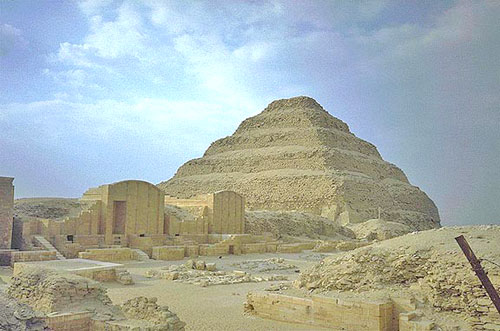
Fig 5-1.
-
Egypt, Aswan quarry: “The
‘Unfinished Obelisk’ near Aswan still lies in its quarry,
detached on all but its lower side. If it had been extracted, it
would have been 41.75 meters (137 ft) high with a base about 4.2
meters on each side. The total weight would have been about 1168
tons, heavier than any piece of stone ever handled by the
ancient Egyptians”.
-
Egypt, Temple of Hatshepsut at
Karnak: “…one of the largest standing obelisks remaining at
Karnak. It is 29.5 meters (96.7 ft) high and weighs 323 tons.”
-
Egypt, Karnak: “The seventh and last
of the Karnak obelisks… is the largest surviving obelisk, with a
height of 36 meters.” This 118 ft obelisk was removed to Rome in
antiquity and now stands in the Piazza San Giovanni in Laterano.
It was shortened to 32 meters (105 ft) when it was re-erected in
the sixteenth century, and its current weight is 455 tons.” (Fig
5-2).

Fig 5-2
Obelisk at Karnak
-
Egypt, Luxor: “Ramesses II placed
two obelisks before the Luxor Temple, only one of which remains,
the other was taken to Paris. The Luxor obelisk is made of red
granite; it is 25 meters (82 ft) high and weighs 254 tons.”
-
Bolivia,
Tiahuanaco and Puma-Punku:
“…stones weigh up to 400 tons…”
“…stones up to 100 tons each, were quarried 10 kilometers away.”
“One block of red sandstone in the platform of the Puma Punku
weighs 131 tons. It had been hauled 10 kilometers.”
-
England, Stonehenge: “…160 stones,
4-37 tons each.” “The ‘sarsen’ stones were moved 20 miles from Avebury, some weighing 30 tons and standing 30 ft high.”
-
England, Avebury: “There were two
hundred or so stones in the circles, the largest of which were
over 55 tons, to be dragged a mile or more from the Downs.”
-
Ireland, Dublin: “…The capstone of
the megalithic tomb at Brenanstown, weighing approximately 67
tons.”
-
Mexico, La Venta: “…some of the (Olmec)
stone “portrait” heads weighing as much as 25 tons.” “Stones
weighing as much as 30 tons were found at Mitla.”
-
Mexico, Quirigua: “…the largest
Mayan stele, at Quirigua, measuring 10.7 x 1.5 x 1.27 meters,
and weighing 65 tons.” “the site of Quirigua is where the
largest monolith in the Maya world stands. It is the Stella E,
weighing 65 tons and standing 35 feet high. It was quarried
about three miles away.”
-
Peru, Sacsahuaman: “…a stone 27 ft
high and weighing over 300 tons.”
-
Peru, Ollantaytambo: Regarding the
six colossal monoliths at Ollantaytambo, “The gigantic stone
blocks are from eleven to almost fourteen feet high, average six
or more feet in width, and vary in thickness from about three to
over six feet.” “…some weighing up to 250 tons.” “…the giant
stone blocks were quarried on the mountain on the opposite side
of the valley. The heavy blocks of red granite, after they had
been quarried, hewed, and shaped, were then transported from the
mountainside, across two streams, and up to the Ollantaytambo
site, carefully raised, put precisely in place, and finally fused together.” (Sitchin, 1990). (Notice the phrase "fused
together".)
-
Lebanon,
Baalbek: “…the colossal
stones, the Trilithon, each weighs about 1100 tons; it is a
weight no modern piece of equipment can even come close to
lifting and moving.” (Fig 5-3). “None of today’s machines could
move these megaliths. The largest block is 21 x 4 x 4 meters and
the two others are 19.50 x 4 x 4 meters. Together they are 60
meter in length and 960 cu meters in volume. The blocks were
quarried 400 meters distant."
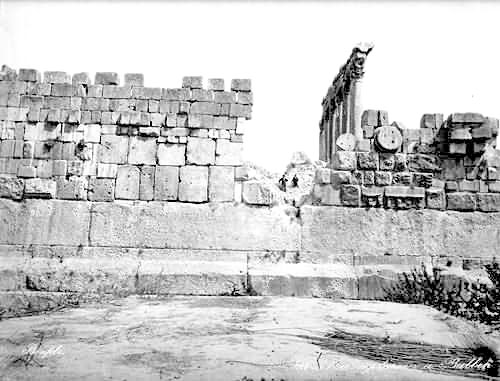
Fig 5-3
Trilithon at Baalbek
“The first of these blocks to the
right (the Trilithon) measures 65’ in length, the second 64’10”,
the third 63’2”. They were all 14’ 6 in height and 12’ in
thickness”.
“…the stone in the quarry, Hajar-el-Hibla ("stone of the
pregnant woman" - below image) is 69’ long, 16’ wide, and 13’10” high…this
enormous stone weighs about 1000 tons” (Fig 5-4).
Apparently
this is the largest construction stone in the world.
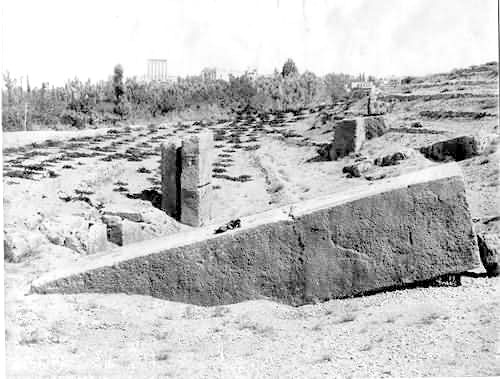
Fig 5-4.
Hajar-el-Hibla at Baalbek
-
Israel, Jerusalem, The Temple Mount:
“The stones were cut with such precision that no mortar was
needed to fit them together. Some of these ashlars (columns) are
as much as 35 feet long and weigh up to 70 tons.”
“The Royal Stoa at the southern end of the mount was built in the shape of
a basilica with four rows of 40 columns each, each 50 feet
high…would weigh about 85 tons each.” “about 60 feet north of
Wilson’s Arch…there are four blocks 11 feet high, one of which
is 42 feet long and 14 feet thick, giving an estimated weight of
1,200,000 pounds…”
-
France, Carnac: “…the 650 foot ‘long
mound’ (Er-Grah), and its relationship to the Grand Menhir
monolith, 65 feet tall and weighing 350 tons (now fallen)…”
-
Malta: “At Tarxien there are three
temples and one Hal-Saflieni, a rock-cut hypogeum. The temples
incorporate stone blocks weighing up to 24 tons each.”
-
Greece, Mycenae, the ‘Treasury of Atreus’:
“One or the lintels over the entrance door measures
9x5x1.2, with an estimated weight of 120 tons.”
“…it is roofed by two enormous slabs, beautifully cut and
polished, of which the inner one measure 3’9” in thickness, and
27.5’ in length on its lower and 29’ on its upper surface; its
breadth is 17’, and it is computed that it weighs approximately
300,000 English pounds.”
-
Easter Island,
Rapa Nui: Of the 300
standing statues the highest is 65 ft; of the 200 unfinished
statues in the quarry, one would have been 164 ft high.
Today, with high strength steel, we are
able to move heavy objects on steel wheels, e.g. a 200 ton autoclave
was moved 750 miles over US western roads on a rig having 112 wheels
and powered by two large diesel tractors.
However some things are
too big to be moved on wheels, and instead steel rollers are used.
The 198-foot-high Cape Hatteras Lighthouse was moved about a half
mile during 1999. It weights well over 1000 tons.
To move the lighthouse a compacted
gravel road was built, on which large steel plates were placed.
Steel rails were then set on the road plates in the direction of the
move. To accomplish the move steel roller “dollies” were placed on
the rails and were driven by powerful hydraulic rams. A total of 400
tons of steel was used directly under the light for support. The
light would be moved a few feet and then the plates and rails behind
it would be unbolted and moved to the front.
Kiloton objects can also be moved on “tank tracks” which are
essentially steel rollers running on steel tracks.
Also steel cranes have been built which can lift several hundred
tons. A New York engineering corporation has a huge hydraulic crane
which can lift 500 tons, which is used to lift smaller cranes to the
tops of buildings under construction. NASA constructed a crane
having a lifting capacity of 430 tons, which is used to lift the
shuttle during attachment to the fuel tanks.
Its been suggested that the huge stones in place at ancient
megalithic sites were moved around on wooden rollers. I think these
authors are not aware of the relative strength of wood and steel.
While a steel T-beam, mounted vertically with both ends fixed, can
support a load of about 100 tons, a 10 inch diameter wood beam of
the same length can only support about 10 tons. And if the wood beam
is laid down so that the load is cross-grain rather than end-on, it
will splinter under a much smaller load.
Furthermore even if they don't splinter
they will deform under the load and will slide instead of roll; this
happened when 20 people tried to move a replica of one of the
statues on Easter Island, and it only weighed 9 tons! So can we
really imagine a group of prehistoric people sliding the 1000 ton
blocks at
Baalbek?
Some Egyptologists suggest that the huge obelisks
were moved on wooden rollers but not a single one has ever been
found. Clearly it’s just nonsense to maintain that these stones were
moved on wooden rollers.
So, when we consider the kiloton stones used at ancient megalithic
sites, especially the monsters at Baalbek, I see three
possibilities:
The first is that a technology comparable to our own existed at that
time, employing high strength metal alloys, hydraulics and powerful
engines. However, such a technology would involve the use of many
materials, including gold and ceramics, which would last many
millennia, and I am not aware of any reports of discoveries of any
such artifacts.
Additionally, since this technology existed all over
the Earth, this possibility requires the difficult assumption that
the members of this entire civilization disappeared, or at least
“forgot” the technology, at about the same time, or in a worldwide
conspiracy, disposed of all of the tools. This scenario seems highly
unlikely.
There are a few references to a second possibility which take us
into the psi world - that the stones were moved by beings having the
ability to control the local gravitational field:
-
Giza, Egypt: “Then said Pharaoh,
‘Where lies the papyrus on which Imhotep wrote the words of
power that went to the building of the pyramid for Zoser, yes
and for that of Seneferu my father also… The words of power can
be found and spoken by none but he-and if he speaks them three
great pyramids shall rise at Giza and stand there forever. But
if he speaks them not, all that you build, and your son builds
and your son’s son after him shall fall and crumble away and
become as the sands of the desert.’”(Green, 1967).
At his "Giza
Oracle" site Patrick Cooke presents a compelling argument that
the Great Pyramid was not built by ancient Egyptians.
-
Uxmal, Mexico: “…construction work
was easy for them… all they had to do was whistle and the heavy
rocks would move into place.”
-
Tiahuanaco, Bolivia: “…(the stones
were) carried through the air to the sound of a trumpet”.
-
Giza, Egypt: “…a magician was said
to have raised into the air a huge vault of stone 200 cubits
long and 50 cubits broad”. (Hancock, 1995)
However with our current level of
technology, ideas concerning anti-gravity and levitation take us
into the realm of the supernatural, and so are out-of-bounds in
these pages.
The third possibility is that aircraft and cables were available at
that time which had the power and strength to lift and move the
stones.
Of course we do not know for sure how these incredibly heavy stones
were quarried, moved, and assembled, and short of a revelation, will
likely never know. But we do know that even the heaviest
construction today is not done with kiloton stones; it’s difficult,
slow and expensive. Logically the only reason for the ancients to
build with such huge stones is because it was easy for them to do
so.
Consider Baalbek in Lebanon where we find a huge platform which
underlies, and predates, the ruins of the magnificent Roman temple
of Jupiter. It contains the largest stones ever used in
construction. How was it built? And by whom?
Here are some clues:
- Michel Alouf (1999) discusses the
many theories concerning the builders of the pre-roman portions
of the site. He came to the conclusion that it was the temple Baalath built by
Solomon, based on the following biblical
passage (I Kings, IX; 17-19):
“And Solomon built Gezer and Beth-Horon, the lower, and Baalath
and Tadmor (Palmyra) in the wilderness, in the land, and all the
cities of store that Solomon had, and cities for his chariots,
and cities for his horsemen, and that which Solomon desired to
build in Jerusalem, and in Lebanon, and in all the land of his
dominion.”
- Childress (2000) mentions
the Kebra Nagast, the spiritual
guide of the Ethiopians, which says that Solomon had a flying
vehicle; also that there are hilltops in Pakistan and Iran where
Solomon is believed to have landed.
- By the tradition of the ancient Jews,
Jehovah was not the only
god in the universe, he was the “only god of this particular
people”; and although by the act of the covenant the Israelites
had committed themselves to the rule of Jehovah’s law, King
Solomon (950 bc) had permitted the worship, apparently even in
Jerusalem, of a rival god, Baal, whose main temple was at
Baalbek (Baalath).
- Near the Golden Gate (Jerusalem) is a small mosque, the “Kurst
Suleiman”. Here legend tells us that, “King Solomon sat watching
the Jann and Genii laboring to build his great monuments in
Jerusalem, Baalbek, and Palmyra.” (Cornfeld,1972) (Jann were a
type of Persian Genii, or "Genius", who had the annoying habit
of stealing cows – to eat, I suppose).
- Throughout the ancient Near East we find images of one or more
people flying in “winged discs”. And we find “genie”, also
called “bird-men” by scholars, who are represented as powerful
humans with wings (Fig 5-5), and sometimes with the face of an
Eagle, and called "eagle-men". Virginia Marin (www.Suite101.com)
writes that Genie, or geniuses, were “…all-powerful. They had
great natural and inventive ability. They were smart and
possessed great mental capacity…”
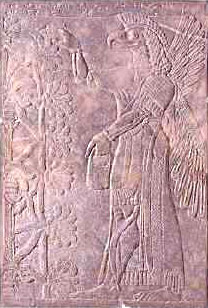
Fig 5-5
I conclude this page by speculating that
the stones were moved by being suspended from powerful aircraft
operated by the AA “geniuses”.
Puedo estar loco, but the stones are there !
Back to Contents
Master Masons
 Yahweh questions Job: Yahweh questions Job:
“Let me ask thee, and answer thou me: Where wast thou, when the
Earth’s foundation I laid out? Say, if thou knowest science: Who
hath measured it, that it be known? Or who hath stretched a cord
upon it? By what were its platforms wrought? Who hath cast its
Stone of Corners?” (my emphasis)
(Job 38:3-8 as translated by Sitchin, 1998)
A unique characteristic of many of the
megalithic sites is the polygonal stones which were used, the “Stone
of Corners”.
At Sacsahuaman, above Cuzco, Peru there is the stone of
Hatun Rumiyoc, a huge polygonal stone with 12 corners, which
interlocks perfectly with adjacent stones. Polygonal stonework was
used at several sites in Peru (Figs 6-1,2 ), Greece (Fig 6-3),
Lebanon (Fig 6-4), Turkey, Egypt and Bolivia, and Easter Island,
among others. Also near the base of the Cheops Pyramid.
Polygonal Masonry
 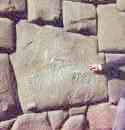 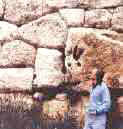 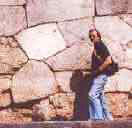
Fig 6-1 Fig
6-2 Fig 6-3 Fig 6-4
Peru Delphi, Greece Baalbek, Lebanon
In addition to being exquisitely hewn
and fitted, some of the stones were actually fused together.
I have
examined the fused joints in the Coricancha in Cuzco (Fig 6-5,
sometimes spelled Koricancha, which in Quechua means "the corral of
gold"), at Ollantaytambo in Peru, inside the Great Pyramid of Egypt
(Fig 6-6) (I was astonished at these joints), and at Delphi in
Greece.
Regarding Ollantaytambo Sitchin (1990) writes that the
gigantic blocks were “…carefully raised, put precisely in place, and
finally fused together.”
Fused Masonry
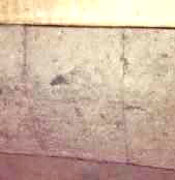
Fig 6-5
Coricancha, Peru
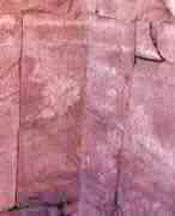
Fig 6-6
Great Pyramid, Egypt
Another skill of the master mason was
the use of single blocks carved as corners, in Egypt (Fig 6-7), and
Peru, among others (see also Zink, 1979).
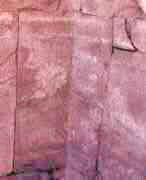
Fig 6-7
One-piece corner
So let's speculate about the technique
of the master masons.
I’m inclined to think that the shaping and
fusing of the polygonal stones might have been accomplished as
follows: Two irregular stones are leaned against each other (Fig.
6-8a).
A high temperature beam (acetylene or electric torch, laser,
ion beam?) is passed back and forth across the contact point A of
the stones, resulting in the first fused joint (b); a third stone is
placed on top of the first two and high temperature shaving is
performed at the contact points B and C (c), resulting in three
fused joints (d).
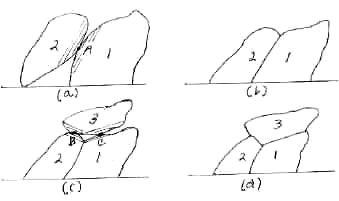
Fig 6-8
Illustrating the joining and fusing of polygonal stones
This scenario of course requires that we
accept that the builders of these ancient, and mostly prehistoric,
structures could easily pick up kiloton stones and place them on top
of each other and could produce a beam sufficiently hot to fuse them
together.
I think they could.
Back to Contents
Desert Artists
"Reality must take precedence over
public relations, for nature cannot be fooled"
– Richard Feynman
"Only within recent years, since the development of universal
communications allowed us to compare the antiquities of our own
countries with those of others, have we been able to see the
extent of the vast ruin within which we all live.
If we ignore
all alterations to the landscape arising within the last three
thousand years and consider the world as it must have looked in
prehistoric times, the pattern that emerges is one so
incompatible with our idea of civilization that it is easy
entirely to miss its significance. For what we find is this: A
great scientific instrument lies sprawled over the entire
surface of the globe.
At some period, thousands of years ago,
almost every corner of the world was visited by people with a
particular task to accomplish.
With the help of some remarkable
power, by which they could cut and raise enormous blocks of
stone, these men created vast astronomical instruments, circles
of erect pillars, pyramids, underground tunnels, cyclopean stone
platforms, all linked together by a network of tracks and
alignments, whose course from horizon to horizon was marked by
stones, mounds and earthworks."
- John Michell (1995)
In 1975 I flew over the Nazca plain in
Peru, since the figures and patterns can only be recognized from the
air, along with a small intrepid group of fellow mystery-mongers.
For me
the Nazca lines represent the most persuasive piece of
physical evidence in support of the Ancient Astronaut (AA)
hypothesis. Although hundreds of writers have generated thousands of
pages about the lines and figures, I have not been able to find a
sensible explanation of how they were made, or by whom, or for what
purpose. It seems obvious that the lines were made from the air.
They could have been used as landmarks to be seen from space, or
perhaps the AA’s were simply venting their artistic impulse on a
convenient giant "etch-a-sketch"; however what I feel is most likely
is that they used the Nazca plain to test and calibrate the
instrument which they used throughout South America, and perhaps
elsewhere on Earth, to delineate "roads" and radial "ceques" linking
important sites.
I think that the lines were probably
created by using an instrument which could sweep away shallow paths
of varying widths. I think "the sweeper" was probably something as
simple as a high-pressure water stream operating in much the same
way as we use a garden hose to wash gravel from our driveways.
Certainly, with the Nazca plain bordering on the sea, there would
have been a plentiful water supply.
Some of the less precise drawings suggest that the sweeper might
have been a gimbaled device which was guided by hand, similar to the
machine-gun mounts on old bombers; however the great precision of
many of the figures suggests that it more likely was a computerized
device which used pre-stored images, such as modern computer driven
routers.
For these drawings the aircraft would have had to hover
quite stably.
Here's how I think they were made:
The 2800 foot long "Needle and
Thread" drawing (Fig 3-1, adapted from Discover Magazine,
December 2000) begins at the bottom of the figure as a wide
beam; the beam is focused to a line as it moves up the "needle";
the artist then uses a oscillatory motion to delineate the
borders of a plateau; and ends up drawing a spiral, a common
motif at ancient sites (perhaps that’s his signature telling us
he is from the galaxy, which also happens to have the shape of a
gigantic spiral!)
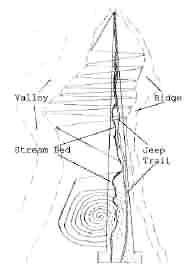
Fig 3-1. "Needle
and Thread" Image, Nazca, Peru
Although most of the figures were
simply outlined with narrow lines, the variable width feature of
the sweeper, as one can also do with the nozzle of a water hose,
permitted the drawing of "filled-in" figures.
The 140 foot long spider (Fig3-2) is one of the best known Nazca
figures. The lines which extend from the rightmost hind leg of
the spider establish that the drawing begins at this point. The
entrance line, the parallel line to the right, started with a
broad beam which was focused to a line, and the hindquarters of
the insect were drawn first.
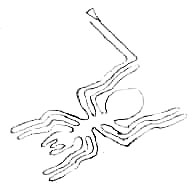
Fig 3-2. The
"Spider"
Most of the other animal figures
were drawn in this same manner, with an entrance line, an
continuous line sketch of the animal, and an exit line parallel
to the entrance line. In Fig 3-3 the entrance-exit line-pair
join the "hummingbird" at the beak.
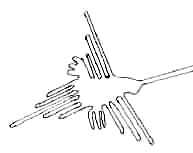
Fig 3-3. The
"Hummingbird"
The "Trident of Paracas", a 600 ft
high drawing over the bay of Paracas demonstrates that the beam
power of the sweeper could be adjusted to provide a much deeper
excavation than was used elsewhere; also the furrows of the
spiral figure at Nazca were reported to be "about a foot deep".

El Tridente
Incidentally the Trident is the largest petroglyph in south
America. Zecharia Sitchin (1990) makes a rather convincing
argument that the Trident of Paracas was the symbol of the
Sumerian god Adad, or ISH.KUR ("He of the far mountains") who
was in charge of mining in SA. His other epithet was ZABAR
DIB.BA ("He who bronze obtains and divides")
Apparently the AA’s sweeper helped the
Incas create their remarkable 25,000 mile "road" system.
Hadingham
(1987) relates that,
"Along the north coast…several sections of Inca
roads run for 25 miles or more with scarcely any visible deviation.
The major coastal artery, in particular, often ignores minor
geographic obstacles, passing straight over rocky hills rather than
curving around them."
For other references on the Nazca lines see Isbella (1978), McIntyre
(1978), Hadingham (1987), Morrison (1988), Von Daniken (1998)
Although the Nazca lines are the most famous, similar lines have
been reported in Bolivia, the USA, Chile, and as "ley" lines in
Great Britain.
Other huge ground drawings can be found on the 2000 ft high Atacama
Desert in Chile, about 600 mile south of Nazca. The desert is
literally covered, for many miles, with "geo-glyphs". Together they
constitute the "zoo of the Atacama", immense stylized figures.
Traveling another 250 miles south, in the region of Tarapaca
province, on a mountain called Cerro Unitas, we find the "giant", a
huge (600 ft) ground figure with "antennae" radiating from the side
and top of it's head. The drawing "cannot be recognized from the
ground since it wraps up over the crest of the mountain." (Clarke,
1982).
This I take to be hard evidence that these figures were
created from the air.
It’s location next to the "lone mountain" also
suggests that it was a beacon. It is the largest known ground
drawing of a stylized figure.

The 30th Parallel
Easter Island
is exactly aligned along a straight line around the center of the
Earth, with the Nazca lines, Ollantaytambo , Tassili
n'Ajjer and the Great Pyramid of Egypt. Other world wonders
that are within one tenth of one degree of this alignment include:
Perseopolis, the capital city of ancient Persia; Mohenjo
Daro, the ancient capital city of the Indus Valley; Khajuraho,
the temple city of the Chandela empire in central India; the
Oracle of Zeus-Amon at Siwa; and the lost city of Petra.
The Ancient Sumarian city of Ur and Angkor temples in
Cambodia and Thailand are within one degree of latitude of this
alignment.
Zecharia Sitchin (1980) writes about the 30th parallel, reporting
that on this line lie the Tilmun site and the "sacred cites" of
Giza-Heliopolis (Egypt), Eridu (Mesopotamia), Persepolis (Persia),
Harappa (Indus valley), and Lhasa (Tibet).
He further suggests that
"Indeed, were we to study all these sites, all of Earth would
probably be encompassed."
The Nazca desert - a testing and calibration site for the devices
used to mark the Earth? by AAs? from the air?
I think so!
Back to Contents
|
























